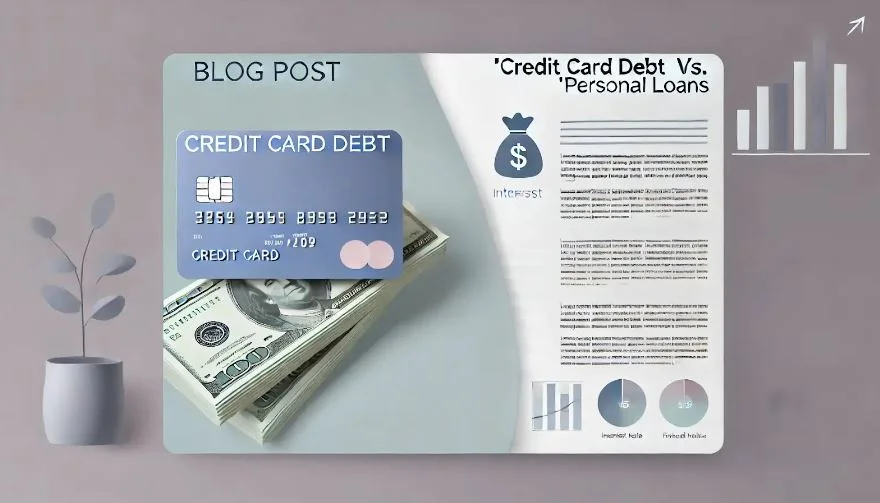
Are you wondering which financial tool is better suited for your needs – credit card debt or personal loans? Choosing between these two popular forms of borrowing can be challenging, especially with the varying costs, repayment options, and long-term impacts on your finances. With the average credit card interest rate sitting around 20% and personal loan rates typically lower, finding the right option to meet your goals is crucial. But what factors should guide your decision?
In this blog, we’ll unpack the key differences, explore the pros and cons of credit card debt and personal loans, and offer guidance on making an informed choice. Whether you’re considering a personal loan for a home renovation or relying on credit card flexibility for daily purchases, we’ve got you covered. So, let’s dive into the comprehensive comparison of credit card debt vs. personal loans and see which option best fits your financial plan.
Credit Card Debt vs. Personal Loans: Understanding the Basics
When comparing credit card debt vs. personal loans, it’s essential to understand how each option operates. Credit card debt functions as a form of revolving credit. This means you have a set credit limit that refreshes as you repay, giving you ongoing access to funds. Credit cards are known for their flexibility in spending and repayment, allowing users to cover daily expenses and make small purchases conveniently.
On the other hand, personal loans are installment loans. When approved, you receive a lump sum that you repay over a set period with fixed monthly payments. This type of loan is often chosen for large, one-time expenses, such as debt consolidation or home improvement projects, and can help borrowers secure a predictable repayment schedule.
The main difference lies in structure: while credit cards offer a revolving line of credit, personal loans provide a one-time disbursement. Both options are generally unsecured, meaning they don’t require collateral. However, they differ in terms of interest rates, fees, and repayment terms, which can impact their long-term affordability.
Key Differences Between Credit Card Debt and Personal Loans
Understanding the differences between credit card debt and personal loans can help determine which option aligns best with your goals.
- Repayment Structure: With credit cards, you’re required to make at least the minimum payment each month, which varies based on your balance. In contrast, personal loans involve fixed monthly payments over a defined term.
- Interest Rates: Credit cards typically have variable interest rates, which can fluctuate. Personal loans generally come with fixed rates, offering more predictable monthly payments.
- Fees and Charges: Credit cards often carry annual fees, late fees, and foreign transaction fees, while personal loans may include origination and prepayment penalties.
- Best Uses: Credit cards are ideal for ongoing, smaller purchases, while personal loans suit larger, one-time expenses requiring a structured repayment plan.
With these differences in mind, let’s explore the benefits and drawbacks of credit card debt vs. personal loans to understand their practical implications.
Credit Cards
Credit cards offer a flexible, revolving line of credit that allows you to make purchases up to a set limit, paying down the balance as needed. They are particularly useful for managing day-to-day expenses and offer benefits like rewards and emergency access to funds.
Let’s start by exploring the pros and cons of using credit cards.
Pros of Using Credit Cards
Credit cards provide several distinct advantages, making them a popular choice for everyday expenses and short-term financial needs. Here are five key pros of using credit cards, supported by statistics and examples.
1. Convenience and Accessibility
Credit cards are widely recognized for their convenience, offering immediate access to funds for daily expenses and emergencies. In 2023, approximately 83% of U.S. adults owned at least one credit card, emphasizing their popularity and ease of use. Unlike personal loans, which require a new application for each loan, credit cards provide a revolving line of credit, allowing users to make purchases as needed within their credit limits. This ease of access makes credit cards ideal for managing both planned expenses and unexpected costs.
2. Rewards and Cashback Opportunities
One of the most attractive features of credit cards is the potential for rewards and cashback. Many cards offer cash back, travel points, or discounts on certain types of purchases. For example, in 2024, it was reported that the average cardholder earns around 1-5% in cashback rewards, which can add up over time. For those who pay off their balance each month, these rewards can effectively reduce spending costs, making credit cards a financially advantageous tool for regular purchases and expenses.
3. Short-Term Interest-Free Financing
Credit cards can serve as a short-term, interest-free loan when used responsibly. Most credit cards have a grace period, typically 21-25 days, during which no interest is charged if the balance is paid in full. This allows users to finance smaller purchases without worrying about accruing interest, as long as they pay off their balance by the due date. According to a LendingTree study, about 47% of cardholders pay their balance in full each month, thus benefiting from interest-free borrowing. This feature can be especially helpful for managing short-term cash flow needs.
4. Safety Net in Emergencies
Credit cards act as a valuable financial safety net, providing immediate funds for unexpected expenses such as car repairs or medical bills. With the national average credit card limit at around $30,000 for prime borrowers, cardholders can rely on their credit line when facing urgent costs without the delay of a loan approval process. This immediate accessibility makes credit cards a preferred choice for emergency spending. However, managing credit card debt responsibly is essential to avoid high interest on unpaid balances.
5. Opportunity to Build Credit
Using a credit card responsibly can be an effective way to build or improve credit scores. Credit utilization (the percentage of available credit in use) and on-time payments contribute significantly to credit scores, with regular credit card use helping build a positive payment history. Studies indicate that responsible credit card use accounts for around 35% of a credit score calculation, making it a valuable tool for borrowers looking to enhance their credit profile. Timely payments and maintaining a low balance can positively impact credit scores over time, helping cardholders qualify for favorable terms on future loans.
Cons of Using Credit Cards
While credit cards offer flexibility and rewards, they also carry potential downsides that can impact financial health if not used wisely. Here are five cons of using credit cards, supported by relevant statistics and examples.
1. High Interest Rates on Carried Balances
One major drawback of credit cards is their high interest rates, which can make debt very costly if not paid off in full each month. In 2024, the average APR on new credit card offers reached 24.92%, meaning balances left unpaid can quickly accumulate interest. Over time, carrying a balance can lead to significant interest expenses, making it harder to pay down debt.
2. Temptation to Overspend
Credit cards can also encourage overspending due to their easy access to funds. With a revolving credit limit, cardholders may feel inclined to spend more than they can afford, especially when only minimum payments are required. According to studies, approximately 47% of credit card users carry a balance month-to-month, indicating a trend of overspending that can create a cycle of debt if not managed carefully.
3. Additional Fees and Penalties
Credit cards often come with various fees and penalties that add to the cost of borrowing. These can include annual fees, foreign transaction fees, and late payment penalties. Some credit cards also have fees for balance transfers, which can reach 3-5% of the transferred amount. These charges can make credit cards an expensive option if not closely monitored, especially for those using cards for international purchases.
4. Potential Negative Impact on Credit Scores
Misusing credit cards can have a negative impact on credit scores, especially if balances are high or payments are late. High credit utilization ratios (amount of credit used vs. available credit) can lower credit scores, and missed payments can hurt credit history. Since 35% of a FICO score depends on payment history, failing to pay credit card bills on time can significantly impact financial opportunities.
5. Risk of Long-Term Debt Accumulation
Credit cards pose a risk of long-term debt accumulation, particularly for those who rely heavily on them for regular expenses. With minimum monthly payments often set low, it’s easy to fall into a pattern of only paying the minimum, which can extend debt repayment timelines significantly. According to reports, paying only the minimum each month on a $5,000 balance with an average interest rate of 18% can take over 17 years to pay off and lead to thousands of dollars in interest. This long-term debt risk makes it essential for users to carefully monitor their credit card spending and prioritize full payments whenever possible to avoid costly and prolonged debt cycles.
Personal Loans
Personal loans provide a one-time lump sum with a fixed repayment schedule, making them ideal for large, planned expenses such as home renovations or debt consolidation. They offer a structured, predictable payment plan, which can be easier to manage over time than revolving credit.
In the following sections, we will discuss the pros and cons of personal loans to help you determine if they align with your financial needs.
Pros of Using Personal Loans
Personal loans offer a structured and reliable borrowing option with several notable benefits for those needing a lump sum.
1. Lower Interest Rates
Personal loans often come with lower interest rates compared to credit cards, especially for those with strong credit profiles. For instance, the average personal loan APR for borrowers with a credit score above 720 hovers around 18.68%, significantly lower than the 24.92% average APR on new credit cards. This lower rate can make personal loans more attractive for large expenses or consolidating high-interest credit card debt, providing substantial long-term savings for borrowers.
2. Predictable Monthly Payments
One major appeal of personal loans is the predictability of monthly payments. Since these loans usually have fixed interest rates, borrowers can count on consistent monthly payments, which helps with budget planning and financial stability. Given that personal loan debt now totals $246 billion in the U.S., with an average loan amount of $11,687 per borrower, many people find these fixed payments manageable and beneficial for larger financial commitments.
3. High Borrowing Limits
Personal loans also typically offer higher borrowing limits than credit cards, which makes them ideal for significant expenses. For example, borrowers with good credit may qualify for amounts upwards of $20,000 to $30,000, whereas average credit card limits are often lower. High-limit personal loans are popular for debt consolidation, as 51.3% of personal loan borrowers in the U.S. use them to refinance or consolidate credit card balances. This usage trend underscores the value of higher loan limits for debt management and major purchases.
4. Structured Repayment Schedule
A structured repayment schedule is another benefit that attracts borrowers to personal loans. With set monthly payments over a fixed period, personal loans provide a clear payoff date, helping borrowers avoid the risk of perpetually revolving debt. This structure contrasts with credit card payments, which often allow minimum payments, potentially keeping users in debt for years. The repayment schedule of personal loans ensures that debt decreases steadily each month, which helps borrowers maintain financial discipline.
5. Reduced Temptation for Additional Spending
Personal loans provide a one-time lump sum, which can help borrowers avoid additional debt. Unlike credit cards that offer ongoing revolving credit, personal loans require the entire borrowed amount to be repaid over time. This structure can be advantageous for those aiming to control spending since it limits the temptation of continuous borrowing. Especially with rising credit card debt, which hit a record $1.142 trillion in 2024, personal loans can be a controlled borrowing alternative for individuals looking to manage spending responsibly.
Cons of Using Personal Loans
Despite their advantages, personal loans come with potential drawbacks that may make them less ideal for some borrowers. Here are five cons of using personal loans, with supporting statistics and examples for context.
1. Lack of Flexibility in Accessing Funds
One significant drawback of personal loans is the lack of flexibility. Once a loan is disbursed, the borrower cannot access additional funds without applying for a new loan. This limitation makes personal loans less suitable for ongoing expenses or smaller, frequent purchases. In comparison, credit cards, which provide a revolving line of credit, are often better suited for continuous spending. Given that around 23.9 million Americans currently hold personal loans, this limitation can become restrictive for borrowers who may need ongoing financial support.
2. Additional Fees and Charges
Personal loans often come with a range of fees that can increase the overall cost of borrowing. These include origination fees, which can range from 1% to 8% of the loan amount, and prepayment penalties that discourage early repayment. For instance, in 2024, the average personal loan debt per borrower was $11,687, which means origination fees alone could cost hundreds of dollars. Late fees are also a concern, as missing payments can incur penalties and negatively impact credit scores. This fee structure can make personal loans costly if not carefully managed.
3. Stricter Qualification Requirements
Qualification requirements for personal loans tend to be stricter than for credit cards, making it challenging for borrowers with lower credit scores to access favorable loan terms. As of 2024, the average APR on personal loans for borrowers with credit scores below 680 was above 30%, which is considerably high. Additionally, some borrowers may need a cosigner to qualify, especially those with credit scores under 600. This restriction can make personal loans an unattainable option for borrowers with limited credit histories or lower credit scores, unlike many credit cards that cater to a wider range of credit scores.
4. Long-Term Financial Commitment
Personal loans typically involve a long-term financial commitment, which may reduce a borrower’s financial flexibility. Loan terms often range from two to seven years, during which borrowers are required to make regular payments regardless of their financial situation. Although this repayment schedule can be beneficial for those needing a structured plan, it may prove challenging if unexpected expenses arise. For example, during the COVID-19 pandemic, many borrowers struggled to meet payment obligations due to income disruptions, highlighting the inflexibility of fixed-term loans.
5. Higher Delinquency Rates Compared to Other Loan Types
Personal loans have relatively high delinquency rates compared to other types of loans. As of 2024, the 60-day delinquency rate for personal loans was approximately 3.91%, higher than for credit cards at 2.26% and much higher than for mortgages at 1.12%. This suggests that borrowers may struggle to keep up with fixed payments over the life of the loan. High delinquency rates can result in additional fees, negative credit impacts, and, for some lenders, even legal actions. This underscores the need for careful financial planning when committing to a personal loan.
Choosing Between Credit Card Debt and Personal Loans for Different Financial Goals
Selecting between credit card debt and personal loans depends on your financial objectives. Different situations call for different strategies, so understanding when to use each can improve financial outcomes.
- Debt Consolidation: When considering debt consolidation, personal loans often provide a lower, fixed interest rate, making them ideal for repaying high-interest credit card debt. However, balance transfer credit cards with 0% introductory APR offers can also be beneficial for short-term debt reduction.
- Large, One-time Purchases: For large, one-time purchases, personal loans are usually the preferred option. The lump-sum distribution and fixed repayment schedule suit significant expenses like home improvement projects, where a structured approach is beneficial.
- Everyday Expenses and Emergencies: In terms of everyday expenses and emergencies, credit cards offer unmatched convenience. With instant access to funds and the potential to earn rewards, credit cards are generally better for daily purchases and short-term needs.
By evaluating your goals, you can determine whether credit card debt vs. personal loans better aligns with your needs, helping you make smarter financial decisions.
Impact on Credit Score: Credit Card Debt vs. Personal Loans
Both credit card debt and personal loans can impact your credit score, but they do so in different ways. Credit utilization and on-time payments are crucial factors in determining their effects.
- Credit Utilization Ratio: Credit card debt affects your credit utilization ratio, which represents the percentage of revolving credit in use compared to the available limit. Keeping this ratio below 30% is recommended to maintain a healthy credit score.
- Payment History: In contrast, personal loans impact payment history more directly. Since personal loans are installment loans, they don’t influence credit utilization as much, but timely payments contribute positively to your credit history.
- Long-term vs. Short-term Effects: Finally, long-term vs. short-term effects differ between the two options. Regular credit card use and repayment can improve scores faster, while personal loans build a consistent record over time, provided payments are made on schedule.
Conclusion
Credit card debt and personal loans both offer distinct benefits and challenges. Credit cards provide flexibility and potential rewards for everyday spending, while personal loans bring predictability and often lower interest rates for larger, one-time expenses. When choosing, consider your financial goals, repayment capacity, and the structure that best suits your needs.
Remember, using credit responsibly, whether through a credit card or a personal loan, can help build a strong credit history. It’s also helpful to explore options by getting prequalified or comparing rates and fees from multiple providers before making a final decision. For those interested in more financial guidance, consult resources that provide insight into effective debt management and borrowing strategies.






